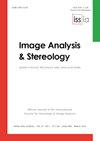从Freeman链码在四个方向上构造四叉树的扩展算法
IF 1
4区 计算机科学
Q4 IMAGING SCIENCE & PHOTOGRAPHIC TECHNOLOGY
引用次数: 0
摘要
本文介绍了Chen和Chen在2001年提出的算法的改进。该算法直接从Freeman链码在四个方向上构造四叉树。我们从两个方面对算法进行了改进:首先,针对Chen和Chen没有考虑的自交情况,提出了一种利用空间填充z阶曲线的时间高效解。其次,将该算法扩展到包含孔洞的几何对象;实验验证了扩展算法的计算效率。本文章由计算机程序翻译,如有差异,请以英文原文为准。
Extended algorithm to construct a quadtree from Freeman chain code in four directions
This paper introduces improvements to the algorithm that was proposed in 2001 by Chen and Chen. The algorithm constructs a quadtree directly from Freeman chain code in four directions. We have improved the algorithm in two ways: Firstly, a time efficient solution using the space filling Z-order curve is proposed for a self-intersection case that was not considered by Chen and Chen. Secondly, the algorithm is expanded to handle geometric objects containing holes. The computational efficiency of the extended algorithm was confirmed by the experiments.
求助全文
通过发布文献求助,成功后即可免费获取论文全文。
去求助
来源期刊

Image Analysis & Stereology
MATERIALS SCIENCE, MULTIDISCIPLINARY-MATHEMATICS, APPLIED
CiteScore
2.00
自引率
0.00%
发文量
7
审稿时长
>12 weeks
期刊介绍:
Image Analysis and Stereology is the official journal of the International Society for Stereology & Image Analysis. It promotes the exchange of scientific, technical, organizational and other information on the quantitative analysis of data having a geometrical structure, including stereology, differential geometry, image analysis, image processing, mathematical morphology, stochastic geometry, statistics, pattern recognition, and related topics. The fields of application are not restricted and range from biomedicine, materials sciences and physics to geology and geography.
 求助内容:
求助内容: 应助结果提醒方式:
应助结果提醒方式:


